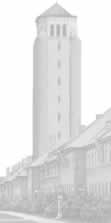VII. Activity at the Fort
a. The Early Years: 1890-1910
b. 1910 - World War I
c. World War I
d. The Years between the Wars
e. World War II
f. The Postwar Years
According to an account of the early buildings by an unknown employee of Holabird & Roche, by 1890, the general layout of the Fort was in place, roads, sewers, and water mains were laid, and the Pumping Station erected and equipped on the lake shore below the high bluff. The Officers’ Quarters, Barracks (#48, #50), Guardhouse (#33), Stables (#42, #43), Bakery (#34), Quartermaster and Commissary Storehouse (#35), Workshops (#36), and Veterinary Hospital (#38) had been completed or were well on the way to completion and the Water Tower (#49) was in use although not entirely finished. The Fort was ready for its first major assignment.
Fort Sheridan’s first military activity began after the Battle of Wounded Knee, which took place in South Dakota in December of 1890. A group of the defeated Lakota tribe were imprisoned at the Fort. By 1894, two years after they were gone from the Fort, all of the individual buildings designed by Holabird & Roche were completed. These included the Officers’ Housing, Bachelor Officers’ Quarters and Mess (#31), the Quar-termaster Stables Guardhouse (#37), the Saddler’s and Stable Sergeant’s Buildings (#44, #72, #78), the Gun Shed (#89), the Army Mess Hall and Central Heating Plant (#47), the Infantry Drill Hall (#60), a Magazine (#57A), Ordnance Storehouse (#59), the Dead House (Morgue) (#87), a Blacksmith Shop (#61), and the Fire Station (#79). A small Cold Storage House (#100) was built in 1897, though the architect is unknown.

Guardhouse without side wings, date unknown.
Lake County (IL) Museum, Regional History Archives, 92.24.1638
In June 1894, Fort Sheridan played a role in the Pullman strike when disagreements between union officials and management of the giant railroad car company erupted in violence. From the time of conception, Fort Sheridan’s mission had been to respond to domestic uprisings, and this purpose was exercised during the Pullman dispute when President Grover Cleveland ordered the 15th Infantry and the 7th Cavalry from Fort Sheridan to deter further confrontation at the Union Stock Yards. The measures taken by the army during the Pullman strike proved to be successful in restoring peace and order in the city, and it was the last time Fort Sheridan would serve its original purpose as a domestic peace keeper In 1898, the Fort served as a temporary transit center for troops on their way to fight in the Spanish-American War.
In these early years, Fort Sheridan became known locally as a "Cavalry Post." Cavalry officers were always highly regarded, leading to Fort Sheridan becoming a social hub of the North Shore. There were balls and receptions at the Officers’ Club and other social activi-ties including guard mounting ceremonies, drills and parades, band concerts, and polo matches with nearby wealthy residents. This aspect of Fort life, however, was limited to the officers and did not extend to the enlisted men.

Officers of the Cavalry Squadron, date unknown.
Lake County (IL) Museum, Regional History Archives, 92.24.989
During the first decade of the twentieth century, a considerable amount of construction took place at the Fort. Holabird & Roche did not play a role except for designing wings that added space to the guardhouse in 1905-1906. All of the other new construction was done by the Office of the Quartermaster General except for the Post Office (#66), built in 1907, and the Post Hospital (#1, #2), built in 1893 and 1905-1906. The hospital buildings were built by the Office of the Surgeon General. It is unknown who designed the Post Office, but the National Historic Landmark nomination states that it might have been built by the Post Engineer. Because of the importance of the cavalry and artillery units to the army, four large structures were built, two on each side of the existing barracks, in 1905 (#81-84). These U-shaped buildings stand 2 1 /2-stories. This same year a 2 1 /2-story house (#28), in the American Foursquare style, was built on the lake at the south side of McArthur Loop to serve as the Field Officer’s Quar-ters (the house of an officer ranked Major through General). In addition, the Office of the Quartermaster General built four 2 1 /2-story cross-shaped duplex homes, three on the north side of the parade grounds and one on the east side, just north of the houses facing Logan Loop. These were to serve as Lieutenants’ Quarters (#92, #95-97). Two slightly larger duplex homes were built on the east side of the parade grounds to serve as Captains’ Quarters (#93, #94). A Quarter-master Storehouse (#85) was also built. In 1907, Bachelor Officers’ Quarters (#32) were constructed to the west of the existing Bachelor Officers’ Quarters and Mess (#31) that had been designed by Holabird & Roche. In 1907-1908, six narrow buildings that served as Company Kitchens (#103 - 108) were constructed south of the barracks. Two large Stables (#86, #98) were built on Lyster Road, increasing the number of structures needed to service the cavalry. In 1910, two structures were built as Hospital Corps and Sergeants’ Quarters (#45, #102) near the southwest corner of the parade ground. No construction of significance occurred again until the 1930s. Only nonpermanent structures were built.

Cavalry Barracks (#81, #82), ca. 1908.
Susan S. Benjamin Postcard Collection
Civil disturbances in Mexico between 1910 and 1916 and the war then beginning in Europe made Congress aware of the country’s state of unprepared-ness. This attitude was profoundly felt at Fort Sheridan when units departed from Fort Sheridan to handle Mexican border skirmishes. The War Department recognized the responsibility the country had in playing a greater role in international affairs and the likelihood that the United States would have to enter the conflicts.
Throughout the country an emphasis was placed on training and readiness, and changes at Fort Sheridan during this time greatly reflected this new mission. Before the early twentieth century, America had relied on a small standing army for its defense, but as international tensions grew, the nation realized that this kind of
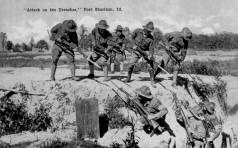
Military training in trenches, ca. 1917.
Lake County (IL) Museum, Regional History Archives, 92.24.276
army was not equal to the task of protecting the nation and its growing population. The need was for training a standby force of men prepared for deployment in case of war. Major General Leonard Wood, Commander, Department of the East between 1910 and 1914, believed future wars would see the greater part of the fighting done by these men. He initiated the reserve training camps independent of state and National Guard structure.
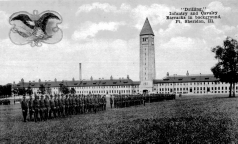
Military training in trenches, ca. 1917.
Susan S. Benjamin Postcard Collection
Fort Sheridan was to serve as the site of the nation’s the first Reserve Officers Training Camp (ROTC). It was held in the summer of 1917 for 2,500 men. A second one immediately followed. To accommodate these large numbers in what had previously been a camp with few barracks, rapid construction com-menced. The result was a village of sixty buildings constructed west of Patten Road and south of Bartlett Ravine. In addition, another twenty-four buildings were constructed in the eastern section of the camp all south of Bartlett Ravine outside the historic district. Approxi-mately 5,800 men who had completed three months’ basic training in the two successive camps were commis-sioned as officers in the Army Reserve, applying in combat what they had learned in their training at Fort Sheridan. The type of training at the Fort reflected the situation in Europe at that time. For infantry and field artillery training, a large trench system was built that emulated those used in the actual European conflict; the men also trained in the areas of drill, horse care, and communications. In addition to providing infantry and field artillery training, the camps maintained significant coast artillery (antiaircraft) and cavalry units. Today Leonard Wood Avenue, encircling the parade ground, commemorates the general’s role in establishing reserve training at Fort Sheridan.
The Reserve Training Camps provided a logical expansion into training centers following the Declara-tion of War on April 6, 1917. Fort Sheridan became an induction and Midwest training center for men entering the Army from Illinois, Michigan, and Wisconsin. As the war in Europe raged and Fort Sheridan continued its role in recruiting and training young men for battle, it also took on several changes including the addition of what was at that time the largest base hospital in the United States, Lovell General Hospital. During its two years of operation the facility treated some 60,000 patients and kept the great influenza epidemic of 1918 from engulfing the base. Temporary wood structures forming the hospital occupied most of the parade ground and the entire tower complex of buildings between 1918 and 1920.
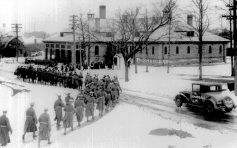
Soldiers marching by Guardhouse. Automobiles prominent on post, ca. 1930.
Lake County (IL) Museum, Regional History Archives, 92.24.1977
Most patients were released and returned to their homes; some were buried in the post cemetery. A sundial was built on the east lawn of the Post Commander’s Quarters at the hospital’s closing in 1920 as a memento to its tenure. A hostess house of the Young Women’s Christian Association, built in 1919, was located in the west area of the parade ground for 24 years before it was razed.
After World War I, several changes occurred that altered the face of Fort Sheridan. These changes, brought about by the introduction of automobiles, tanks, and trucks in battle, included the phasing out of the cavalry as a prominent part of the post and the construction of numerous support structures for automobiles, machinery, and related equipment. Consequently, the field where the cavalry and artillery displayed their expertise with horses was converted to ball fields. A school for automobile mechanics was set up by the Quartermaster Corps in 1941. This school marked the end of an era, as blacksmiths, wheelwrights, and wagonmasters gave way to the all-purpose me-chanic.
In 1921, the Bakers’ and Cooks’ School was estab-lished and a large Georgian Revival building (#140), designed by The Stearnes Co. of Chicago, was con-structed in 1939 south of the stables on Ronan Road. The school operated through World War II. In 1932, at the intersection of Westover and Lyster Roads, the Theater (#180) had been built in the Georgian Revival style. Throughout the 1930s, Works Progress Adminis-tration (WPA) funds were used in the repair and renovation of numerous officers’ quarters, outbuildings, and support facilities.
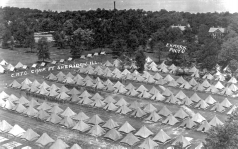
Civilian Military Training Camp—tent village.
Named for General Leonard Wood. 1926.
Lake County (IL) Museum, Regional History Archives, 92.24.1396
In the period between 1920 and 1943, Fort Sheridan remained active as a reserve training facility while retaining its role as a regular army training base. As part of the War Department’s mandate to foster a closer relationship between air and ground fighting, the Coast Artillery (antiaircraft) established a major training center at the Fort. The soldiers who trained in anti-aircraft units lived in the tent village of Camp Leonard Wood under often harsh conditions until 1939, when a permanent structure, located south of Bartlett Ravine on Patten Road, was built.
After 1936 the Fort, like others across the country, prepared itself for the possibility that the United States might enter the war in Europe. When the peacetime draft was instituted in 1940, Fort Sheridan became one of four Recruit Reception Centers in the country and was expanded to receive masses of new selectees and recruits from Illinois and other states. Soldiers were received at the Recruit Reception Center, known to the men as "Boomtown," located at the south end of the post. In order to accommodate the heavy influx of new recruits, numerous temporary prefabricated buildings were constructed. When the physical requirement for the soldiers became more strenuous, an increased training program was established. Part of that training involved setting up and utilizing an elaborate infiltra-tion course at the post, designed to take soldiers through a simulated battlefield. The infiltration course became a standard training device during World War II.
In 1944, Fort Sheridan assumed administrative control of prisoner of war camps in Illinois, Michigan, and Wisconsin. A total of 15,000 prisoners under this administrative control performed civilian construction jobs, crop harvesting, kitchen police, and other forms of manual labor. When World War II ended, the POW camp that had been at Fort Sheridan closed, and all but nine of the prisoners returned to their homeland (most were from Germany). Those nine are buried in the post cemetery.
In the years following World War II, the regular army
units stationed at the Fort were sent to main battle areas. During the
Korean conflict of the 1950s Fort Sheridan served as a primary reception
center. Fort Sheridan’s mission was then expanded to include the
support of defense sites protecting a Midwest industrial area that encompassed
Illinois, Indiana, Michigan, Wisconsin, and Minnesota. The post became
responsible for all logistical support of a network of 33 Nike-Hercules
missile sites throughout the country. During the Vietnam conflict, the
Fort served as an administra-tive and logistics center in addition to
sending its regular army units into battle areas.
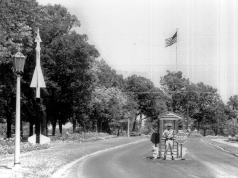
Fort Sheridan entrance, ca. 1965.
Lake County (IL) Museum, Regional History Archives, 92.24.949.1
At the end of the Vietnam War, a peacetime army was stationed at the Fort, and Fort Sheridan continued to function as an administrative center. In the early 1970s there were several attempts by Congress to close Fort Sheridan. However, the post endured, and in 1975 it had the largest permanent and civilian contingent in its history. In the 1980s, it served as a center for recruiting activities in eleven states. Nevertheless, over the course of the 1980s, construction at the post slowed as its contingent dwindled. There were approximately 1,400 military personnel stationed at Fort Sheridan in 1988, down from 5,000 in 1975. By that time there were no regular combat troops there, and its main function was to supervise reserve activities around the Midwest and to coordinate Army recruiting nationwide. It also served as headquarters to the 112th Military Intelligence Command, the Army Criminal Investigation Command, and a detachment of explosives experts.
Although the post was among the first to be closed during the initial round of military budget cuts in 1990, training and administrative activities continued at the base until it closed. Troops from Fort Sheridan served actively in Desert Shield and Desert Storm after the post was ordered to mobilize active, reserve, and National Guard units for the conflict. Following the Gulf War, the army began deactivating units and departing from Fort Sheridan. With this war over and the Cold War relegated to history, Fort Sheridan ended its 106-year military mission. Closing ceremonies took place May 28, 1993.
Send any Fort-related news update information to mrtollfree@aol.com

